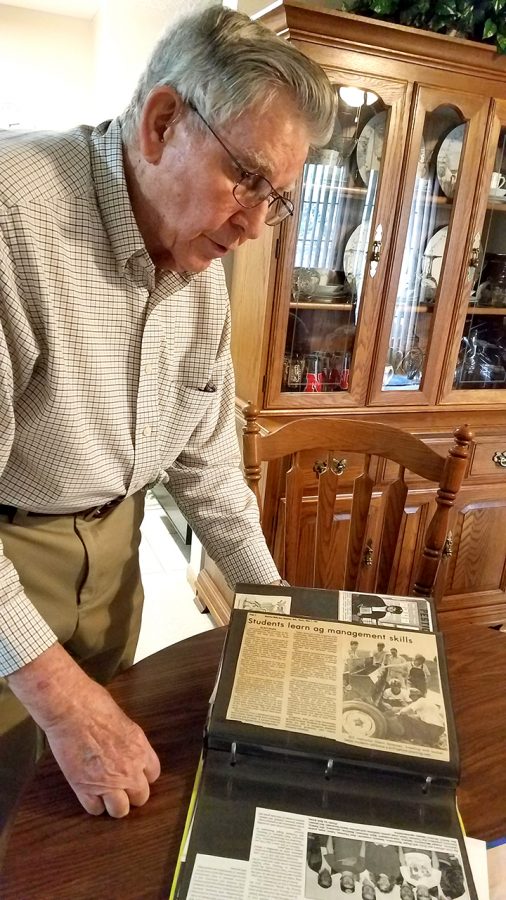Retired Ag instructor to donate original drawings
Glen Sorensen, above, looks through a scrapbook of articles from his time with the college.
April 30, 2019
Retired developer of the Southeast Community College (SCC) Ag program is donating original layout drawings to the Beatrice Campus.
Glen Sorensen, now 87, recounts the history of designing and developing the agriculture center, which, nearly 40 years later, is still in use. His home, now in Lincoln, includes two scrapbooks filled with newspaper articles and awards received during his time at SCC.
Originally, the Ag program was on the Milford campus, though they had no land or animals of their own. According to Sorensen, they just went out to different farms in the area.
Sorensen was hired by SCC in September of 1980 to design a state-of-the-art agriculture center. He drew up the layout for the buildings, oversaw the entire construction and wrote the curriculum for the classes.
With good weather in the fall of 1980, the buildings were ready to go, and the first Ag classes were held in the new facility in January of 1981.
At the top of the donated picture of the original drawings is an aerial photo of the completed buildings. The photo was taken by Linn Sunderland, retired SCC faculty member.
Born in 1932, Sorensen was raised on a hog and dairy farm, but the family fell on hard times through the Great Depression, drought and World War II, and his father was killed in a tragic tractor accident on Sorensen’s eighth birthday.
In addition, cholera swept through their farm, killing all 20 of the hogs as they were ready for market, causing them to lose the family farm.
Using that tragedy as inspiration, in 1965, he designed and patented a state-of-the-art swine system.
Sorensen said, “My goal in life was to make a better sanitary system to raise hogs.”
Though that patent was never used, he used a similar version of the swine gestation building at the Beatrice Agriculture Facility. Other buildings included five livestock confinement buildings, a feed processing facility with a classroom and an animal health facility with classroom.
Sorensen said, “A successful health and nutrition program is the key to the success of the Ag program.”
He did all veterinarian work in the health facility except caesarean sections to keep it disease free.
Sorensen also designed a waste handling system which included two lagoons.
The animal waste went into the first lagoon where the liquid was then pumped into the second lagoon leaving the sludge behind. The second lagoon then was used as an irrigation system.
Though Sorensen walks a little slower these days wearing ankle braces for arthritis and his voice a bit shaky, his memories are clear and spoken with fondness about his SCC days.
The Ag program at Beatrice started with just nine students, eight males and one female, he recalls. When he retired in 1992, the program had grown to around 190 students with only a handful being females.
According to Robin Moore, Administrative Director, Institutional Effectiveness & Research, the Ag program has remained strong with enrollment numbers in the last 10 years fluctuating between 141 and a high of 220 in the 2014-2015 academic year. The percent of females has grown though to an average of nearly 19% with a high of 22.5% in the current academic year.
Sorenson developed and taught Livestock Nutrition, Swine Production, Beef Production, Livestock Management and Animal Health.
In the fall of 1984, Sorensen moved to the Crop Production area of the Ag program teaching Irrigation and Water Management, Ag Chemicals and Safe Pesticide Use, Soil Science and Soil Testing, Agronomy and Ag Chemical Equipment Safety and Application.
Starting the Crop Production with no equipment, he found a used 8-foot John Deere drill for the college to purchase, which they used to plant 35 acres of oats to prepare the soil for an alfalfa crop.
Changes were constant with new pesticides, herbicides and insecticides.
He used modern techniques of the Global Positioning System (GPS) for setting up the irrigation systems starting in the late 1980’s.
His students worked with him on every aspect of farming, including working with Natural Resources Districts (NRD) officials in developing a layout for the campus watershed dam used to stop erosion and for irrigation of crops.
In 1990, Sorensen and his students worked in conjunction with the University of Nebraska—Lincoln and Natural Fibers Corporation of Ogallala on the Milkweed Research Project.
This project was to help determine the potential viability of milkweed as crop, but Sorensen noted that SCC’s soil was not right for growing milkweed, which is used as insulation as well as pillow stuffing.
Sorensen was also active in the SCC Ag Club, involved in the Faculty Association and served on the Beatrice Chamber of Commerce Agriculture Committee.
In his time, Sorensen never had an injury or accident.
“Safety was the key,” he said, “always safety first.”
Sorensen said about half of the students he taught went back to the family farm with their experience and knowledge of so many different aspects of farming. The other half went into other areas of agriculture such as chemicals, equipment dealers or selling seed and feed.
The SCC Ag program has seen changes over the years since Sorensen retired in 1992, including the use of drones.
The donated document will hang in the building north of the current Ag center which will be remodeled to become the new Ag building sometime in the future.

